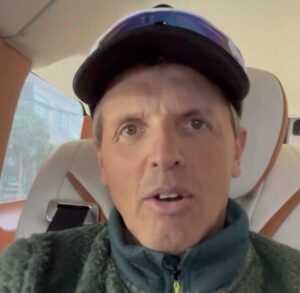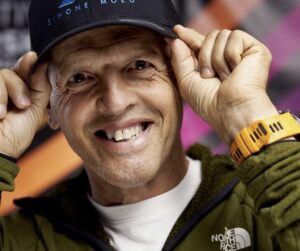In summer 2019, Sajid Sadpara became the youngest person to summit K2. This year, the 22-year-old dreamed of becoming the youngest to step on his country’s highest mountain in winter. Instead, he survived a traumatic solitary descent of the mountain, after leaving his father behind.
Back home, he had to deal with both his own sadness and that of his family. He has also had to navigate unfamiliar attention — honors, public admiration, and the media clamoring to hear his story. Often, these published accounts have misinterpreted technical details (hours, locations) or made real errors, such as the last words between Sajid and his father at the foot of the Bottleneck. The BBC, for example, recently suggested that Ali insisted that his son should keep going to the summit at all costs, despite problems with his oxygen mask, when in fact it was the opposite.
Ali Sadpara’s close friends, Rao and Moirah Ahmad, have kindly translated our questions to Sajid, and conveyed his answers to us, as well as helped detail the events of February 4-5. The Ahmads served as the Sadparas’ spokespeople throughout the expedition and so have the background to properly present Sajid’s amazing story.
January 15 — The Nepali Summit Push
John Snorri and Ali were in Camp 2 for the second day. Originally, they had planned to go up to Camp 3, but a pessimistic forecast and a strong wind where they were discouraged them from going further. Nevertheless, they sent Sajid up to bring some gear to Camp 3.
Sajid reached the lower Camp 3 at 7,000m, where he met Sergi Mingote and JP Mohr. Mingote asked Sajid: “Are you guys not going to the summit with the Nepalis? They are leaving tomorrow.”

The three-man team of John Snorri (centre), Sajid (left), and Ali Sadpara. Photo: John Snorri
Snorri and Ali knew nothing of the Nepali plans and only found out when Sajid returned to where they waited in Camp 2, below the Black Pyramid, too far away to join the push.
That day, Mingote wrote that they were in the Japanese Camp 3 and the “two strong teams on O2 [meaning Purja’s and Mingma G’s] are one camp above. With the good forecast for tomorrow, they may try it [the summit],” Mingote concluded, later mentioning that he saw Sajid earlier, bringing Snorri’s gear to C3.
At the end of his post, Mingote wished Purja and Mingma G’s teams all the best. There were no further posts from Mingote. On January 16, the Nepalis summited and Mingote tragically perished during his descent.
February 4-5 — The Second Summit Push
Nearly 40 people started up K2 at the beginning of February, buoyed by the short weather window predicted for February 5. While the odds of summiting were low, and although some of the climbers retreated from Camp 1, about 20 people reached Camp 3 between 3 pm and nearly 8 pm on February 4.
Colin O’Brady was first, then his Sherpas with his tent, then Juan Pablo Mohr, who also carried a tiny two-person tent for himself and Tamara Lunger. Ali carried the tent he would share with John Snorri and Sajid. Apparently, one of the Sherpas had another tent. And that was all.
Snorri and the Sadparas ended up sharing their tent with at least three more people, unable to lay down, change socks, eat, or melt snow for water. Most of all, they couldn’t get any rest before their final push. For that reason, the three of them set off toward the summit later than planned.
Snorri, the slowest in the team, left at 11:30 pm. Ali, always fast on the mountains, followed at 2 am. Both used supplementary O2 — each carried two bottles.

K2 under the stars. Photo: Tamara Lunger
Sajid set off at midnight, two hours ahead of his father, since he was using no supplementary O2. He wanted to try and bag a no-O2 summit for Pakistan, as well as to break the winter age record since he is five years younger than Gelje Sherpa, who was the youngest on the Nepali team that summited three weeks earlier. Nevertheless, he carried one bottle for an emergency, plus an extra bottle for Snorri.
On the way, he crossed paths with Slovenian Tomaz Rotar, who was on his way down after being unable to cross what he described as an “unpassable crevasse 2.5m wide” at around 7,800m.
Eventually, Ali caught up with Sajid, and they saw Snorri and Mohr at the edge of the crevasse. Together, they jumped the crevasse. Sajid is positive that there was no rope and that the jump was very long and “pretty scary”. But they neither used nor fixed any ropes.
Where did they cross the crevasse?
This is one of the most confusing parts of the story. Sajid said that the three of them knew about the crevasse because the Nepalis told them about it after their summit. However, Mingma G has explained that after failing to find a way to pass this obstacle on the Abruzzi route, he and those with him retreated almost back to Camp 3, where they took a different way, more or less following the Cesen route. They found a passage around the crevasse with a very steep ramp on the other side.
Mingma G noted that right after Camp 3 there was no rope, but the fixed line started 250 to 300m above camp. It then continued up the entire route to the summit. He also remarked that the crevasse was fixed with rope.

Sajid Sadpara in Base Camp, with Broad Peak behind. Photo: Elia Saikaly
Could Snorri, the Sadparas, and JP Mohr have taken a different way, following the Abruzzi Spur rather than the Cesen, and therefore crossed the crevasse at a different point, far from the ropes? If so, the team soon returned to the main path, because there were ropes at the Bottleneck, Sajid says, when he turned around.
Sajid’s retreat
Sajid says that as they proceeded up, he developed a splitting headache. This is why his father told him to start using O2 before they proceeded up the Bottleneck. They were at 8,200m and it was 10 am. “The sun was shining, everyone was climbing well, and feeling good,” said Sajid.
But when Sajid tried to switch on the oxygen, his regulator failed, with oxygen leaking out. Ali then gave him a radio and told him to return and wait back in Camp 3. Already suffering from the symptoms of AMS, Sajid admits that he can’t recall the descent well. “At about noon, I have this memory of looking back and seeing my father and the rest on top of the Bottleneck, about to start the Traverse, but I am not sure anymore if that was real or if I dreamed it,” he said.
Somehow, he crossed the crevasse again. “I nearly fell,” Sajid said. “I jumped and only one of my feet reached the other side.”
He managed to make it safely back to Camp 3 by 4 or 5 pm. “I don’t know why it took me so long to get there,” he admitted.
He made some tea and contacted Base Camp. At 7 pm, the weather worsened. At around 11 pm, Sajid went outside and looked for the headlamps of his father and the others, but he saw nothing. The following morning, the crew in Base Camp convinced him that he had to go down, to save his own life.
“I do not think they got sick, they were feeling fine,” said Sajid. “There must have been some kind of accident.”
It takes about five hours from the beginning of the Bottleneck to the summit. If everything went well, they could have reached the summit by 3 pm. Sajid, Snorri’s widow Lina, Rao Ahmad, and all Pakistan wish that they summited before their fatal accident. The fact is, no one can know for sure. The agreed-upon call from the summit never came, neither from the climbers’ satphones nor their InReach trackers, which can send SMS messages.
The thorough investigation that followed the climbers’ disappearance discovered that Snorri’s Thuraya satphone had apparently tried to make a call at 7:17 pm that day at the altitude of Camp 3 — not right on the tent’s location but closer to the Cesen route. Just in case, the helicopters made sure to search that precise area, but they found nothing.
However, there was no way to know if this was a real call or some system glitch. If real, it is not known if it was a pocket dial or a deliberate call to a number. In either case, the communications company can’t determine the number that Snorri might have been trying to reach, according to Moirah Ahmad.
The later flights up and down their route, the plane carrying infrared cameras, the ground search by four climbers from Ali and Sajid’s village…all found no trace of the trio. So their fate belongs to the mountain, unknown at least until their bodies are discovered, and left for us to speculate what might have caused them to vanish into the jaws of K2.






